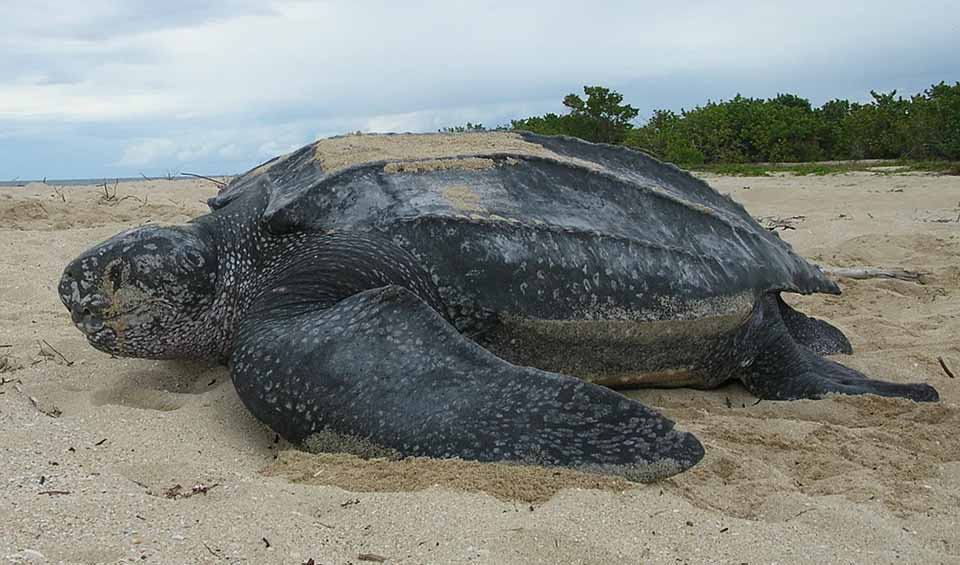An ancient mariner of our oceans, with a lineage dating back 100 million years, tracing its origins to the era when dinosaurs roamed the earth. Despite surviving natural cataclysms that extinguished many other species, today’s Leatherbacks face threats that have caused their numbers to decline precipitously in modern times.
Leatherbacks are truly unique among sea turtles. Instead of a hard shell like other species, they have a distinctive flexible carapace that is covered in leathery skin, hence their name. This specialized shell is composed of a matrix of bony plates beneath the skin, allowing for a more hydrodynamic shape that aids in deep diving and long-distance swimming. Their adaptability in thermal regulation, a rare trait for reptiles, allows them to maintain a core body temperature that can function effectively in a wide range of water temperatures. This is partly why they can be found in all oceans, from the tropics to the subpolar regions.
Renowned for their epic migratory journeys, Leatherbacks traverse thousands of miles between their nesting beaches in tropical regions and their feeding grounds, which can be located in temperate and even subpolar latitudes. This extensive travel is driven by their need to consume vast quantities of jellyfish, which form the bulk of their diet and are more abundant in cooler waters.
The global distribution of Leatherbacks is categorized into seven Regional Management Units (RMUs), which are essentially subpopulations that are geographically and sometimes genetically distinct. Each RMU faces its own set of challenges, but there are common threats that imperil Leatherbacks across the globe.
Distribution
 Atlantic Ocean
Atlantic Ocean Indian Ocean
Indian Ocean Pacific Ocean
Pacific Ocean Albania
Albania American Samoa
American Samoa Angola
Angola Anguilla
Anguilla Antigua & Barbuda
Antigua & Barbuda Argentina
Argentina Aruba
Aruba Australia
Australia Bahamas
Bahamas Bahrain
Bahrain Bangladesh
Bangladesh Barbados
Barbados Belize
Belize Benin
Benin Bermuda
Bermuda Bonaire Sint Eustatius And Saba
Bonaire Sint Eustatius And Saba Bosnia And Herz.
Bosnia And Herz. Brazil
Brazil British Virgin Is.
British Virgin Is. Brunei
Brunei Cambodia
Cambodia Cameroon
Cameroon Canada
Canada Chile
Chile China
China Colombia
Colombia Comoros
Comoros Congo-Brazzaville
Congo-Brazzaville Costa Rica
Costa Rica Croatia
Croatia Cuba
Cuba Curaçao
Curaçao Cyprus
Cyprus Côte D’ivoire
Côte D’ivoire DR Congo (Kinshasa)
DR Congo (Kinshasa) Dominica
Dominica Dominican Republic
Dominican Republic Ecuador
Ecuador Egypt
Egypt El Salvador
El Salvador Equatorial Guinea
Equatorial Guinea Eritrea
Eritrea Fiji
Fiji France
France French Guiana
French Guiana French Polynesia
French Polynesia Gabon
Gabon Gambia
Gambia Ghana
Ghana Greece
Greece Grenada
Grenada Guadeloupe
Guadeloupe Guam
Guam Guatemala
Guatemala Guinea-Bissau
Guinea-Bissau Guinea
Guinea Guyana
Guyana Haiti
Haiti Honduras
Honduras India
India Indonesia
Indonesia Ireland
Ireland Israel
Israel Italy
Italy Jamaica
Jamaica Japan
Japan Kenya
Kenya Kiribati
Kiribati Korea
Korea Lebanon
Lebanon Liberia
Liberia Libya
Libya Madagascar
Madagascar Malaysia
Malaysia Marshall Islands
Marshall Islands Martinique
Martinique Mauritania
Mauritania Mauritius
Mauritius Mayotte
Mayotte Mexico
Mexico Micronesia
Micronesia Montenegro
Montenegro Montserrat
Montserrat Morocco
Morocco Mozambique
Mozambique Myanmar
Myanmar Namibia
Namibia New Caledonia
New Caledonia New Zealand
New Zealand Nicaragua
Nicaragua Nigeria
Nigeria Nort. Mariana Is.
Nort. Mariana Is. North Korea
North Korea Palau
Palau Panama
Panama Papua New Guinea
Papua New Guinea Peru
Peru Philippines
Philippines Portugal
Portugal Puerto Rico
Puerto Rico Russia
Russia Saint Helena
Saint Helena Saint Lucia
Saint Lucia Saint Martin
Saint Martin Saint Vincent
Saint Vincent Samoa
Samoa Senegal
Senegal Seychelles
Seychelles Sierra Leone
Sierra Leone Sint Maarten
Sint Maarten Slovenia
Slovenia Solomon Islands
Solomon Islands South Africa
South Africa Spain
Spain Sri Lanka
Sri Lanka St. Kitts & Nevis
St. Kitts & Nevis Suriname
Suriname Syria
Syria São Tomé & Príncipe
São Tomé & Príncipe Taiwan
Taiwan Tanzania
Tanzania Thailand
Thailand Togo
Togo Tonga
Tonga Trinidad & Tobago
Trinidad & Tobago Tunisia
Tunisia Turks & Caicos
Turks & Caicos Tuvalu
Tuvalu US Virgin Islands
US Virgin Islands United Kingdom
United Kingdom United States
United States Uruguay
Uruguay Venezuela
VenezuelaRecent Updates
March 2024: In the Pearl Islands of Panama, marine conservation biologist Callie Veelenturf and her team are tagging turtles with satellite devices. This effort, part of The Leatherback Project, aims to track migrations of leatherback sea turtles and other species to aid their protection.
Feb 2024: Conservation groups petitioned the U.S. Fish and Wildlife Service to update critical habitat protections for the leatherback sea turtle under the Endangered Species Act, focusing on safeguarding key nesting beaches in Puerto Rico and considering additional sites.
Did you know?
- Their deepest dive ever recorded, reaching over 1.2 km( 4,000 ft) was deeper than other marine mammals.
- The leatherback turtle can grow up to 2 m (7 ft) long and weigh more than 2,000 pounds; it is the biggest turtle on Earth.
- The carapace’s seven ridges contribute to its more hydrodynamic structure.
- They use a special set of adaptations to create and retain body heat to maintain warm body temperatures in chilly water.
- Warming temperatures and climate change threaten the leatherback population’s long-term reproductive success.
- The decaying ocean plastic that resembles their primary prey, such as jellyfish, salps, and siphonophores, is ingested by leatherbacks, posing a serious threat to their survival.
Anything we've missed?
Help us improve this page by suggesting edits. Glory never dies!
Suggest an editGet to know me
Terrestrial / Aquatic
Altricial / Precocial
Polygamous / Monogamous
Dimorphic (size) / Monomorphic
Active: Diurnal / Nocturnal
Social behavior: Solitary / Pack / Herd
Diet: Carnivore / Herbivore / Omnivore / Piscivorous / Insectivore
Migratory: Yes / No
Domesticated: Yes / No
Dangerous: Yes / No






